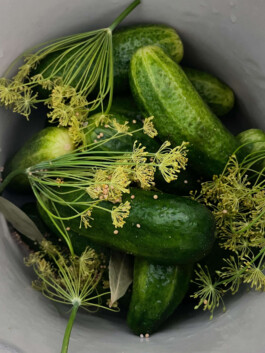
Lacto–Fermented Dill Cucumbers
Beginning with my all-time favorite snack from childhood, a very simple, healthy and delightful one—
dill pickles (no sugar or vinegar involved). A tongue-tingling mix of sweet, salty, sour and crispy.
All you need is: fresh pickling cucumbers, garlic, dill, bay leaves, toasted pepper corns and mustard seeds and salt for the brine. Add grape leaves (or oak or sour cherry leaves) for the base and top. The tannins in the leaves will keep the cucumbers crispy and crunchy.
Using a balanced ratio of salt in fermentation encourages the growth of healthy bacteria. You’ll need a little more salt for cucumbers—a 3–5 % brine, instead of the usual 2 %, otherwise they go too soft. I always measure the salt with a scale to be more precise, since different types of salt on a tablespoon can also have different weights on a scale.
When vegetables are lacto-fermented the bacteria consume sugar and generate lactic acid that will sour the vegetables and preserve them at the same time. These processes will be explained further but if you want to dive in deeper right away I dearly recommend to have a look at the listed resources and the work of David Zilber, Sandor Katz and Kirsten K. Shokey.


INGREDIENTS
1 kg cucumbers
1 liter water
30–50 g mineral-rich, non–iodized salt. I like to use unrefined sea salt
3 fresh dill flowers
2 garlic cloves (you can add one more if you like)
1 teaspoon of toasted black peppercorns and mustard seeds
a few bay leaves, 2–3 are good
Grape leaves (or other leaves with tannins), 2–3 should be enough per 1 liter jar, for the bottom and top, they will keep your cucumbers crispy and crunchy
Optional:
2 teaspoons coriander seeds, toasted
Tarragon (good when making cornichons)
PREPARATION
1. Clean your jar or fermentation pot with hot water.
2. Rinse the cucumbers and carefully remove the ends with a knife.
3. Collect your spices and toast the seeds.
4. Now you can layer everything. Start with the grape leaves and then carefully pile the cucumbers and spices in a clean jar.
5. Carefully measure the salt and water ratio to create the salt brine. Use 30–50g salt / liter of water (for a 3–5% salt brine). Then pour it over the cucumbers.
The cucumbers should be fully covered with the salt brine. A fermentation weight can help keep them down. If the cucumbers are not fully covered they can develop mold. If you find some white Kahm yeast on top in the first few days, just remove it carefully with a spoon–no need to worry.
6. Let the cucumbers rest at room temperature (18–22 °C) for about seven days, making sure they are not in direct sunlight. Then transfer them to a cool place, either in the fridge or basement for another 5 days. Enjoy them right away (or let them ferment a little longer for more aroma), they are best while still crunchy.
Note
You can let the cucumbers sit in cold water for a couple of hours prior to pickling in case they are not freshly picked.
“Fermentation is definitely a commitment. By definition it requires seeing something through. It's being responsible for life and watching it grow. It's a slow and patient process.”
— David Zilber


Lacto–Fermented Dill Cucumbers
Beginning with my all-time favorite snack from childhood, a very simple, healthy and delightful one—
dill pickles (no sugar or vinegar involved). A tongue-tingling mix of sweet, salty, sour and crispy.
All you need is: fresh pickling cucumbers, garlic, dill, bay leaves, toasted pepper corns and mustard seeds and salt for the brine. Add grape leaves (or oak or sour cherry leaves) for the base and top. The tannins in the leaves will keep the cucumbers crispy and crunchy.
Using a balanced ratio of salt in fermentation encourages the growth of healthy bacteria. You’ll need a little more salt for cucumbers—a 3–5 % brine, instead of the usual 2 %, otherwise they go too soft. I always measure the salt with a scale to be more precise, since different types of salt on a tablespoon can also have different weights on a scale.
When vegetables are lacto-fermented the bacteria consume sugar and generate lactic acid that will sour the vegetables and preserve them at the same time. These processes will be explained further but if you want to dive in deeper right away I dearly recommend to have a look at the listed resources and the work of David Zilber, Sandor Katz and Kirsten K. Shokey.
INGREDIENTS
1 kg cucumbers
1 liter water
30–50 g mineral-rich, non–iodized salt. I like to use unrefined sea salt
3 fresh dill flowers
2 garlic cloves (you can add one more if you like)
1 teaspoon of toasted black peppercorns and mustard seeds
a few bay leaves, 2–3 are good
Grape leaves (or other leaves with tannins), 2–3 should be enough per 1 liter jar, for the bottom and top, they will keep your cucumbers crispy and crunchy
Optional:
2 teaspoons coriander seeds, toasted
Tarragon (good when making cornichons)
PREPARATION
1. Clean your jar or fermentation pot with hot water.
2. Rinse the cucumbers and carefully remove the ends with a knife.
3. Collect your spices and toast the seeds.
4. Now you can layer everything. Start with the grape leaves and then carefully pile the cucumbers and spices in a clean jar.
5. Carefully measure the salt and water ratio to create the salt brine. Use 30–50g salt / liter of water (for a 3–5% salt brine). Then pour it over the cucumbers.
The cucumbers should be fully covered with the salt brine. A fermentation weight can help keep them down. If the cucumbers are not fully covered they can develop mold. If you find some white Kahm yeast on top in the first few days, just remove it carefully with a spoon–no need to worry.
6. Let the cucumbers rest at room temperature (18–22 °C) for about seven days, making sure they are not in direct sunlight. Then transfer them to a cool place, either in the fridge or basement for another 5 days. Enjoy them right away (or let them ferment a little longer for more aroma), they are best while still crunchy.
Note
You can let the cucumbers sit in cold water for a couple of hours prior to pickling in case they are not freshly picked.
“Fermentation is definitely a commitment. By definition it requires seeing something through. It's being responsible for life and watching it grow. It's a slow and patient process.”
— David Zilber

a pinch of salt
c/o Tamara Pešić
Ludwigstraße 197
63067 Offenbach
Germany
Pick up & drop times:
Wed, 16:00–19:00
Sat, 13:00–16:00
© Copyright 2022
a pinch of salt
c/o Tamara Pešić
Ludwigstraße 197
63067 Offenbach
Germany
Pick up & drop times:
Wed, 16:00–19:00
Sat, 13:00–16:00
© Copyright 2022